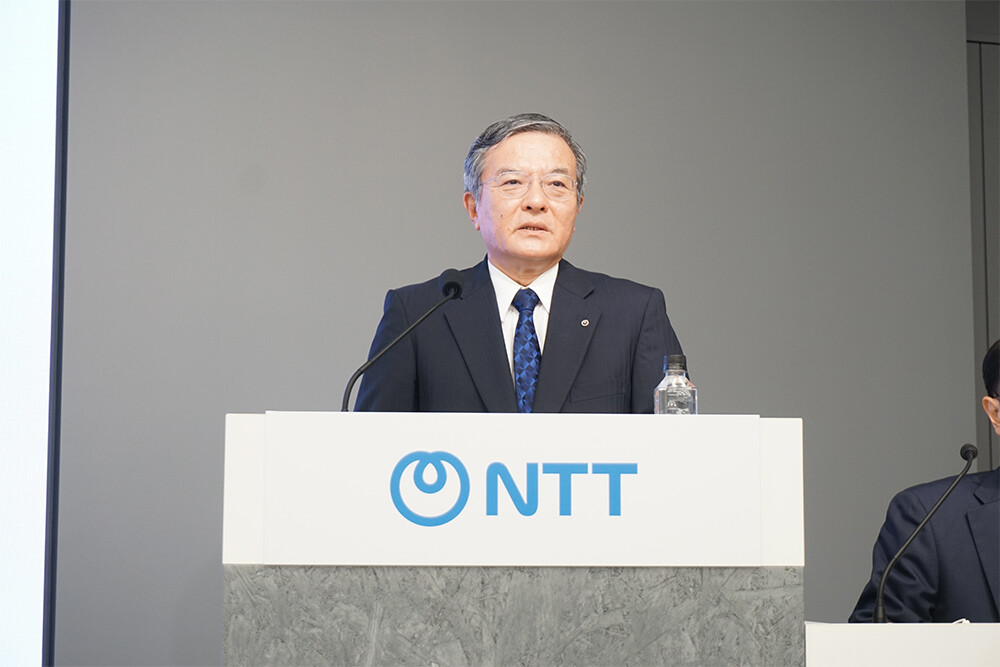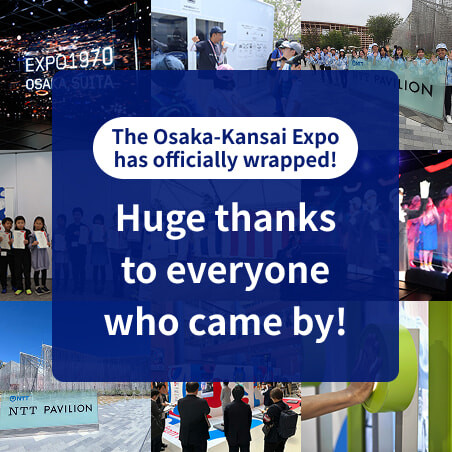Microsoft ends support for Internet Explorer on June 16, 2022.
We recommend using one of the browsers listed below.
- Microsoft Edge(Latest version)
- Mozilla Firefox(Latest version)
- Google Chrome(Latest version)
- Apple Safari(Latest version)
Please contact your browser provider for download and installation instructions.
When you select a year, you can see the list of articles for the selected year.
August 6, 2025
CEO Press Conference
Financial Results for the First Quarter of FY2025
Representative Member of the Board, President and CEO Akira Shimada
(Attendees)
Senior Vice President, Head of Finance and Accounting Toshihiko Nakamura
Senior Vice President, Head of Corporate Strategy Planning Akitoshi Hattori

(President Shimada)
Thank you very much for gathering here today in this intense heat of 36.6 degrees.
I will now explain the financial results for the first quarter of fiscal year 2025.
Our consolidated results for the first quarter show higher revenue but lower profit compared to the same period last year. Operating revenue reached a record high for a first-quarter result. Despite a negative foreign exchange impact of around 50 billion yen, operating revenue increased by 22 billion yen year on year to 3.262 trillion yen, driven by revenue growth from the expansion of corporate business across group companies.
In terms of profit, while NTT EAST and NTT WEST saw increased earnings, NTT DOCOMO recorded a decline due to lower mobile communication service revenue and initiatives to strengthen its customer base and enhance mobile network quality. As a result, EBITDA decreased by 13.9 billion yen year on year to 801.4 billion yen, and operating profit decreased by 30.6 billion yen to 405.2 billion yen. Both operating revenue and operating profit progressed roughly as planned. Although foreign exchange had an impact, we will continue to pursue steady cost reduction and expansion of our corporate business to achieve our consolidated targets for the fiscal year. Net income decreased by 14.4 billion yen year on year to 259.7 billion yen, reflecting the decline in operating profit.
Next, I will explain revenue and profit by segment.
In the Integrated ICT Business Segment, although mobile communication service revenue declined, overall revenue increased year on year thanks to organic growth in Smart Life and corporate businesses, particularly in the financial sector. Despite higher profit from the corporate business and ongoing efforts to improve profitability, operating profit decreased year on year due to initiatives to strengthen the customer base and enhance network quality. As a result of these efforts, cumulative MNP net additions for the first quarter were positive. To achieve our annual targets, we will continue to strengthen competitiveness by reinforcing the customer base and improving network quality while ensuring cost reductions and expanding growth areas such as Smart Life and corporate businesses.
In the Global Solutions Business Segment, while demand for digital transformation in Japan contributed to higher revenue, the negative foreign exchange impact of around 50 billion yen resulted in revenue and profit being roughly flat year on year.
In the Regional Communications Business Segment, although legacy business revenue declined, overall revenue and profit increased year on year thanks to growth in corporate and optical network services. The number of optical service subscriptions also increased year on year, driven by the stronger promotion of 10 Gbps plans and bundled plans for apartment buildings.
In the Others (Real Estate, Energy and Others) revenue and profit increased year on year thanks to the expansion of data center engineering at NTT Urban Solutions.
Next, I will touch on five topics.
First, regarding the upgraded fully domestic large language model, tsuzumi 2.
NTT originally developed the fully domestic LLM "tsuzumi," and the second-generation model, tsuzumi 2, will be released in October this year. The new model has significantly improved its ability to understand complex contexts and meanings required for interpreting internal documents and manuals, one of the most frequent customer requests. For example, in responding to accounting manual inquiries, answer accuracy has improved fourfold compared to the previous model. Benchmark comparisons with other companies' models show competitive performance. Tsuzumi 2 retains its strong cost-performance advantage of operating on a single GPU, making it suitable for on-premises environments. As a fully domestic model, it ensures secure handling of highly confidential information. We hope you look forward to the upgraded tsuzumi 2.
Second, regarding the listing of NTT DC REIT on the Singapore Exchange.
NTT DC REIT, a real estate investment trust managed by NTT DC REIT Manager, a consolidated subsidiary of NTT DATA Group, was listed on the Singapore Exchange on July 14 this year. By transferring six data center assets to the REIT, we aim to shorten the investment recovery cycle, secure new investment funds, maintain financial soundness, and further expand our data center business while maximizing corporate value.
Third, regarding IOWN use cases at the Osaka-Kansai Expo.
At the NTT Pavilion Days held on May 24 and 25, we presented "Cho-Kabuki Powered by IOWN: Hanakurabe Senbonzakura Expo 2025 ver." featuring real-time collaboration between Japan and Taiwan through bidirectional transmission over IOWN APN. At the NTT Pavilion, we also showcased an optical computer using IOWN 2.0 technology that consumes only one-eighth the power of conventional systems. We plan to launch a commercial version in fiscal 2026 with twice the communication capacity compared to the Expo version.
Fourth, regarding our future policy for fixed-line telephone services.
For fixed-line services using NTT EAST and NTT WEST's copper-based infrastructure, we plan to gradually transition to services utilizing optical and mobile technologies by around 2035, considering the aging of existing facilities and declining cost efficiency. We will maintain an environment where customers can continue to use fixed-line services as before. To ensure a smooth transition, we will provide sufficient notice and transition periods to minimize inconvenience to customers. The basic policy is scheduled to be announced by NTT EAST and NTT WEST around late September.
Finally, regarding our medium-term management strategy, progress since May is as shown in the distributed materials.
That concludes my presentation.
Q&A Session
-
Regarding the Integrated ICT Business Segment, could you explain the financial impact of the new rate plans launched by NTT DOCOMO in June, as well as the impact of making SBI Sumishin Net Bank a DOCOMO subsidiary, and the outlook for the second quarter and beyond?
First, concerning the new rate plans, as announced yesterday when we introduced the new basketball-related plan, we launched DOCOMO MAX in June. We are pleased that approximately 700,000 customers have already subscribed. The monthly average is about 350,000, and with an annual target of 3 million, we believe we have made a solid start. We have also added NBA content, and we hope to further enhance customer satisfaction through this offering.
Regarding SBI Sumishin Net Bank, the process of making it a subsidiary has not yet been completed, but it is expected to be finalized around October. It will be consolidated from that point onward, meaning that roughly half a year's performance will be reflected in this fiscal year's results. -
Please tell us about the specific demand and strategy for the commercialization of photonic-electronic convergence devices planned for 2026. Also, given that companies such as NVIDIA are developing similar technologies, what do you consider to be NTT's strengths in IOWN, and how do you plan to promote them?
The optical switch being used at the Osaka-Kansai Expo operates at about 51 terabits per second. For the commercial version to be released next year, we plan to offer one exceeding 100 terabits, which has already been well received by customers. We plan to hold a briefing session on IOWN on October 6 from an IR and PR perspective and, if possible, invite representatives from the optical switch supply chain who use photonic-electronic convergence devices. While details are not yet finalized, we expect to provide more concrete information on potential customers within this fiscal year.
As for NTT's strengths, NVIDIA announced its CPO approach this spring, but the original concept of bringing light close to the chip was proposed by NTT. By realizing this concept, we can significantly reduce power consumption and also address thermal management issues that can no longer be handled solely by electricity. We have heard positive feedback recognizing the value of this concept, which suggests that the direction NTT has pursued is being acknowledged as the right one. NTT also possesses unique technologies, and by highlighting these strengths, we intend to move toward commercialization together with our partners. -
Regarding the announcement of your policy for providing fixed-line telephone services, will you disclose specific geographic areas by late September? Also, how long will the overall transition period be? Could you explain again the need and significance of withdrawing from copper-based services?
Fixed-line telephones currently operate over copper lines. In disaster-prone regions, rebuilding copper lines after typhoons or floods is not efficient, so we would like to avoid doing so whenever possible. As we have previously mentioned, existing equipment will reach its operational limit around 2035, so we hope customers will gradually transition to alternative services by then. We plan to first inform customers of how they can switch to alternative services and, in September, explain our overall policy, although we will not be able to present specific geographic areas at that time. Ideally, we would like to begin the transition in urban areas where optical cable installation is mostly complete. We will continue listening to various opinions and requests and ensure that customers can transition smoothly to appropriate alternative services.
-
Will the announcement of the fixed-line policy take into account the universal service obligation newly introduced under the revised NTT Law?
The basic premise is that customers who currently use NTT's services will transition to alternative offerings. However, some customers may choose to move voluntarily to other providers, such as mobile carriers. Further discussion will be needed, but it may be possible for NTT EAST and NTT WEST to provide services on behalf of, or wholesale to, mobile carriers in designated areas. Some customers may feel more comfortable being contacted directly by NTT EAST or NTT WEST, so we would like to design a system that accommodates such cases and preferences. In areas where optical networks are already in place, shifting customers to fiber is also desirable from the perspective of promoting broadband adoption. We plan to provide more concrete details around September.
-
Please explain the specific factors behind the decline in NTT DOCOMO's revenue, particularly in the telecommunications business. Is it correct to say that ARPU and MNP figures are performing well?
One factor is that we increased marketing expenses, particularly from the third quarter of last fiscal year onward, to strengthen our customer base. Compared to the previous year, marketing costs rose, and we also incurred additional expenses for improving service quality by increasing the number of base stations by about 20 percent. These costs offset the positive contributions from Smart Life and corporate businesses. ARPU was flat year on year in the first quarter, so while we need to continue monitoring, we believe it has bottomed out.
-
In a recent survey by Opensignal on 5G SA, NTT DOCOMO was partially excluded from the evaluation. What is your view on that, and what is the schedule for 5G SA going forward?
We believe the exclusion occurred because in many areas both 4G and 5G signals are available simultaneously. Since there also appear to be differences in the number of surveyed locations for other carriers like SoftBank and KDDI, it is difficult to draw conclusions at this stage. We consider 5G SA to be the core of our 5G services and plan to begin offering it to corporate customers in areas where it can be effectively applied.
-
Given Japan's longstanding shortage of IT personnel and the wave of layoffs driven by AI adoption in the U.S. and elsewhere, what are NTT DATA Group's hiring plans? Will you continue to increase headcount, or are you considering adjusting your recruitment strategy?
We are aware that workforce reductions have begun in regions such as North America as AI progresses, but we believe the situation largely depends on market conditions. When markets recover, companies will both adopt AI and require personnel for consulting and integration work related to that transition. Therefore, the spread of AI does not necessarily mean an overall reduction in employment. On the contrary, the demand for AI engineers and consultants will likely increase.
For this fiscal year, NTT expects to receive around 150 billion yen in AI-related orders, and by fiscal 2027, that figure could grow to around 500 billion yen. Consequently, we will continue hiring AI-related personnel globally. On the other hand, in areas such as contact centers, where chatbots and web-based processes are replacing traditional operations, the need for certain resources may decline. In short, the impact of AI adoption will vary by field, and we do not believe it will lead to a uniform decrease in overall employment. -
What impact do you expect from the change to a Trump administration and the possible reintroduction of Trump-era tariffs on NTT DATA Group's business?
NTT DATA Group is not directly involved in import or export activities, so we do not expect a direct impact from the tariffs themselves. However, if tariffs negatively affect the global economy, IT investment could decline. Therefore, we will need to monitor economic trends closely. In Germany's automotive market, where many of our clients operate, we are already seeing effects from recessionary factors rather than tariffs, so we are somewhat concerned.
-
What is your view on the recently announced partnership between au Jibun Bank under KDDI and SBI Securities? Will this affect your relationship with Monex and SBI Securities?
Since NTT entered into a capital and business alliance with SBI Holdings, we cannot say that there is no connection at all. However, NTT has not invested directly in SBI Securities, so we are not in a position to comment on its partnerships. We will continue to maintain equal business relationships with both Monex and SBI Securities.
-
Rapidus recently showcased a prototype. What is your view on their progress so far, and what are your future investment plans?
Our Chairman Sawada attended the recent opening ceremony and reported that he was impressed by the state-of-the-art, fully automated factory. We are pleased that such an advanced semiconductor facility has been completed. We made an initial investment of around one billion yen and have high expectations that photonic-electronic convergence devices will be integrated into the post-processing stages. Based on that outlook, we plan to continue providing investment support as appropriate.
-
Could you provide an update on your collaboration with Toyota announced last year, and the developments at Woven City?
We continue to make progress in our joint initiative with Toyota to achieve a society with zero traffic accidents through the combination of mobility, AI, and communications. Discussions have advanced significantly. Since the Woven City project is Toyota's initiative, we prefer not to comment further.
-
Regarding competition in mobile pricing, how have other carriers' pricing strategies affected DOCOMO's performance? Please share your reflections on the first quarter and your outlook for the second quarter and beyond.
It is difficult to precisely assess the impact of competitors' pricing strategies at this time. With DOCOMO MAX, we have introduced plans that include bundled services such as DAZN and international roaming, and the number of subscribers has exceeded our expectations, indicating positive customer reception. DOCOMO MAX is not a price increase but a new pricing option that reflects the added value of these services. By continuing to add attractive content, such as the recently announced NBA package, we aim to further enhance customer satisfaction and deliver services that offer genuine value.
-
What is your assessment of NTT DOCOMO's network quality improvement efforts?
The number of new base stations planned last year was exceeded, and all installations have been completed. This year, we plan to increase that number further and accelerate progress by starting earlier in the fiscal year. For tuning work, in areas like Shibuya Station where new buildings continue to appear, ongoing adjustments are necessary, but in most other areas, improvements were largely completed last year.
-
At the Ministry of Internal Affairs and Communications' market review committee, three mobile carriers expressed concerns about collaborations between NTT DATA and NTT EAST/WEST. What is your view and your policy going forward?
From the perspective of antitrust law, since we already held a majority stake, we believe that making NTT DATA a wholly owned subsidiary would not affect fair competition. When NTT DATA was spun off, it voluntarily submitted a statement outlining fair competition conditions, which have since been codified and institutionalized. By adhering to these rules, we see no particular cause for concern.
Currently, NTT DATA's share in the solutions business is about 11 percent, which does not indicate a dominant market position. NTT EAST and NTT WEST are also bound by rules that prohibit certain preferential practices in service provision, so as long as these are followed, we believe there should be no issues requiring debate. -
With the improved performance of tsuzumi 2, what new applications do you foresee, and in what fields do you expect practical adoption to advance?
In large language models, increasing the number of GPUs enhances performance by enabling more parameters. Tsuzumi 2 can increase its parameter count to 30 billion with just a single GPU, which greatly improves cost performance and price competitiveness.
As for applications, the scope remains similar to that of the original tsuzumi. In Japan, successful AI adoption requires customized implementation and consulting tailored to each company. Through such consulting, if we determine that a different provider's LLM better suits a client's needs, we recommend that solution instead of tsuzumi. Last year, we delivered about 800 AI projects worldwide, and we believe this flexible, customer-first approach provides the greatest benefit. While tsuzumi remains our flagship model, we will continue promoting it alongside flexible, tailored solutions. -
What is your outlook on future collaboration with Rapidus under the IOWN Initiative?
While we aim to offer products using 2-nanometer chips in the future, there are no specific plans at this stage. As various new devices emerge, demand will likely increase, and concrete opportunities will arise. One of the biggest challenges in the supply chain is managing heat in data centers. Cooling methods such as water cooling, which circulates water around the frame, or immersion cooling, which submerges equipment in liquid, consume large amounts of power for both cooling and air conditioning. Reducing this energy consumption is a major issue.
By incorporating optical wiring into the back-end processes, we can lower both power and heat, helping to gradually resolve the data center heat management problem. This, in turn, will enhance the value of the semiconductors produced by Rapidus. From that perspective, we look forward to supporting their efforts as much as possible.
Corporate


NTT Group Medium-Term Management Strategy
New Value Creation & Sustainability 2027 Powered by IOWN
We announced our new NTT Group medium-term management strategy which is based on the fundamental principle "Innovating a Sustainable Future for People and Planet" in May 2023
NTT STORY
WEB media that thinks about the future with NTT










